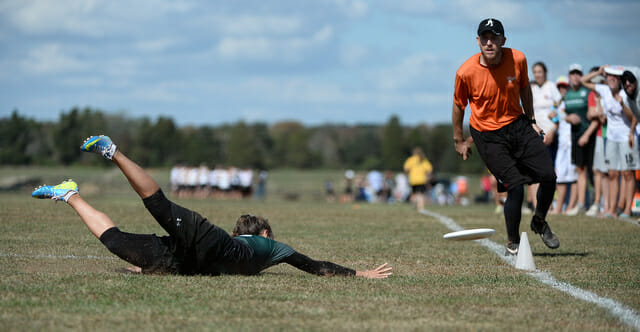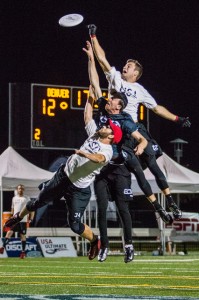How can you determine what's a strip and what's a hand block?
February 23, 2015 by Sean Myers in Analysis with 12 comments

Whether you like it or not, it’s a fact: third-party officials have been around ultimate for a while now. Whether it’s in the AUDL or MLU as an active referee, or in USA Ultimate as a passive observer, many games of ultimate now have a neutral third party on hand to resolve disputes. Together, these officials have logged thousands of hours watching others play ultimate, with an eye on how to accurately make difficult calls. The lessons that officials have learned over these hours makes them a treasure-trove of advice for regular ultimate players who are faced with a foul call in an un-officiated game and looking for something other than volume and unverifiable claims of “he stripped it; I felt it.”
After numerous interviews with AUDL referees and USAU observers, here is a glimpse into the wealth of experience that these officials — particularly observers, who generally have dozens more games under their belt — have gained, focusing on several common scenarios: Marking fouls, up / down calls, airspace fouls, and receiving fouls on undercuts.
1. Marking Fouls
The difference between a strip and a hand block can be miniscule. According to USA Ultimate rule XVI.H.3.D, when the disc is in the offensive player’s hand, and the defender makes contact with the disc to knock it away, it’s a strip. Once the offensive player releases the disc, though, that strip becomes a clean block. Determining the exact time the defender made contact with the disc is a Herculean task, or at least one for Hawkeye. So officials have found a way around it.
“If the throw goes forward, then it’s probably a foul,” USAU observer Joel Houmes said. “If the throw comes out and goes straight down or backwards, it’s probably not a foul.” This is because, when the disc is still in the thrower’s hands, the thrower still has some semblance of control over where it’s going. Once it’s out of their grasp, though, they lose all of that control, and any contact that the defender makes on the disc greatly influences its flight pattern.
This rule-of-thumb also applies to those players who like throwing hucks immediately before laying a hook on their mark’s jaw and calling foul.
“If the disc was still in his hand when the contact occurs, than it’s going to be a really ugly-looking throw,” Houmes pointed out. “If it was a good throw, then there’s contact, that contact was on the follow-through, which isn’t a foul because the disc was out of the thrower’s hand.”
While the flight of the disc is not a fool-proof way of determining whether there was a foul or not, it can be used by officials to determine whether the disc was still in the thrower’s control when contact was made, the linchpin in the foul call.
2. Up/Down Calls
Any catch below mid-shin can result in someone calling it “down.” This often has to do with the fact that, when you grab one side of a disc, the other side of the disc typically drops downwards, which can make it look like it hit the ground first. Just as often, though, it has to do with defensive players making “hopeful” calls without really seeing the play.
The consensus on making these calls is that it’s all about positioning to get the best perspective. For observers, this generally means being in front of the receiver, and with no one screening the play – on under cuts, the observer behind the play will almost always have the best perspective, while on deeper plays, the upfield observer is hustling to stay beside or in front of the action. On under cuts in unofficiated games, it will typically be the handlers who have the best view of whether a throw hit the ground before the catch.
Best perspective will almost never be the player guarding the receiver in this scenario. Unfortunately, on hucks, this will often mean that no one on the field will have a quality perspective, especially if the receiver bids directly away from the other players. In these cases, the “best” perspective will come from the sideline, or from the player closest to the sideline, and furthest up the field – everyone else will likely have been screened from the call.
3. Airspace Fouls
Thousand of hours of officiating experience or not, hospital passes are still a mess. When numerous players are clustered together under a floating disc, it’s nearly impossible to tell whose arm is whose, let alone whether someone is violating someone else’s airspace. Nevertheless, observers have found that their passive role on the field can be useful in this scenario. Because USAU observers can only make a call when asked to by the players, sometimes the call at issue is much easier than it once seemed.

An excellent example of this was the 2014 Men’s Semifinal between Denver Johnny Bravo and Toronto GOAT. With Bravo leading 12-11, Jeff Lindquist sent a deep shot to Cameron Harris, who was being defended by Henry Konker and Stanley Peterson. The throw fell incomplete for a turnover, but Harris called a foul. While Konker seemed to try to body Harris at the last second, he ended up off-balance, with the play above and behind him, and unable to get any strength into a jump. Peterson, on the other hand, came over Harris’ back, pushing Harris forward and potentially violating Harris’ airspace to get the D. It would have been a huge call, taking away an incredible block by Peterson, but the observers didn’t have to make it: Harris called the foul on Konker. By letting the players try sorting it out, the observers had a much easier call to make.
Another thing that officials have found helpful in resolving — or avoiding — airspace issues is whether the player calling the foul actually made an attempt to jump. The Principle of Verticality states that players have a right to “enter the air space immediately above their torso to make a play.” (Rule XVI.H.3.B.3). However, if a player does not exercise that right to their airspace, then there is no foul. This is why it was not a foul when Beau Kittredge jumped over that guy: By the time the defender left his feet, Kittredge had the disc and the play was over. The fact that Kittredge landed his jump so balanced strongly suggests that the defender didn’t exercise his right to his airspace when Kittredge was occupying it – any upward momentum would’ve gone straight into him, which would make it nearly impossible for him to land correctly.
Players in an unofficiated game can use these lessons, as well. If the person calling the foul points a finger at the wrong player, it might result in a much easier call to resolve, and can often diffuse a tense situation. Additionally, players calling an airspace foul need to actually exercise their right to the space above them before making a call. It can be clear if the person calling the foul jumped by how he and others move or change direction in the air, or by how off-balance they land.
4. Receiving Fouls On Under Cuts
The cutter breaks in for an under cut, but the defender plays it well. The thrower tries to squeeze in a throw, but the defender lays out, reaching around the cutter’s body, and nips it away at the last second. The cutter calls a foul, or maybe a strip.
It happens at least once a game, and it can be difficult to determine if the defender knocked it away in time, or if the cutter got possession first.
Like with marking fouls, the flight of the disc can be used as an indicator.
“If the disc continues in the general direction in which it was thrown, it’s very unlikely that the receiver stopped the rotation of the disc and attained possession,” Houmes said. “If the disc goes back in the direction that it came from, it’s a little more dicey. It could still be a block, but it could also be a strip.”
Another useful clue is the sound that the contact makes. Like in basketball, a slapping sound of hand on arm is a good indicator of a foul. On the other hand, the familiar bwomp sound is typically a good indication that the defender got a solid block: because the receiver is trying to cushion it for a catch, it is unlikely that you’ll ever hear that sound when someone gains possession of the disc, which has to happen in order for a strip to be called.
***
All of these are useful tools that observers and referees have found helpful for on-field calls that would be incredibly difficult to make otherwise. They can also be used to objectively argue the outcome of a play in a game of unofficiated ultimate. By using facts of the game that everyone can see – where the disc went after the strip or the fact that a receiver stayed flatfooted while being skied – players can trump the overly-heated arguments about who’s wrong when they say “ I felt a hand” or “I got all disc” with evidence that can’t be denied.